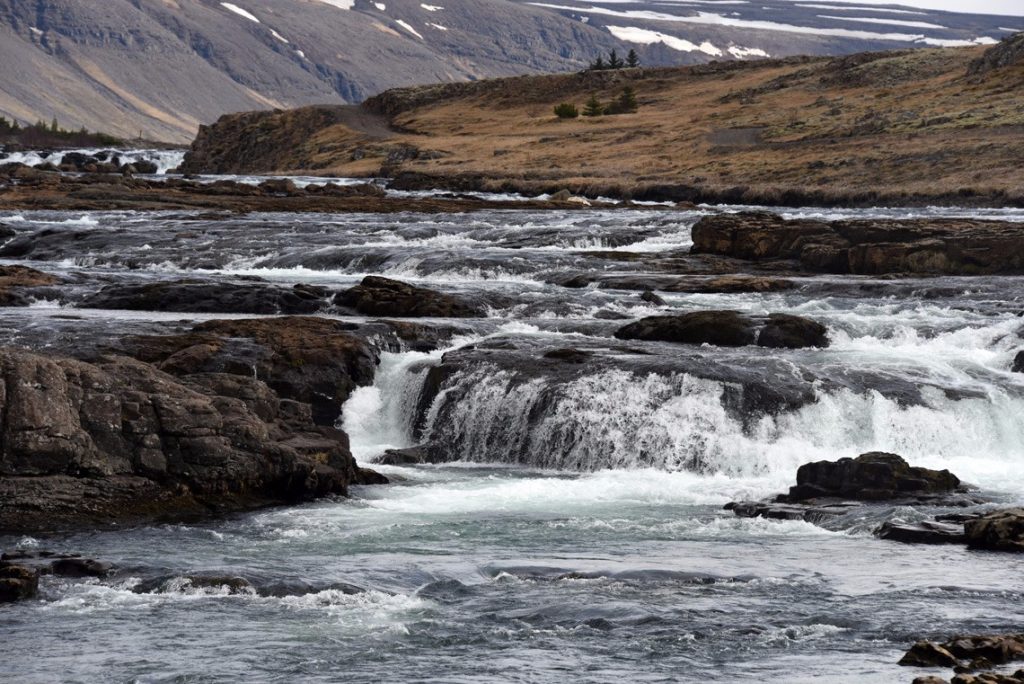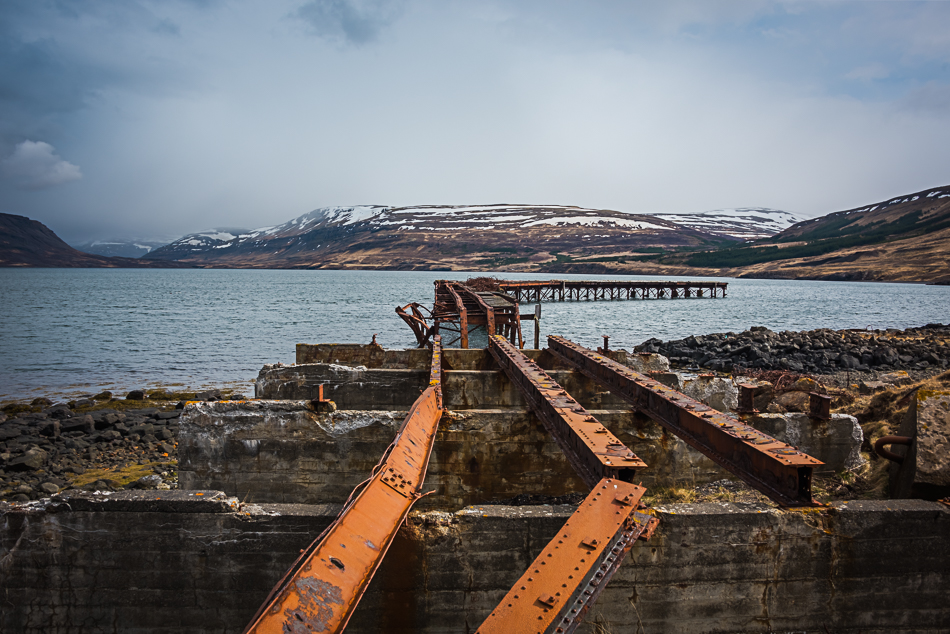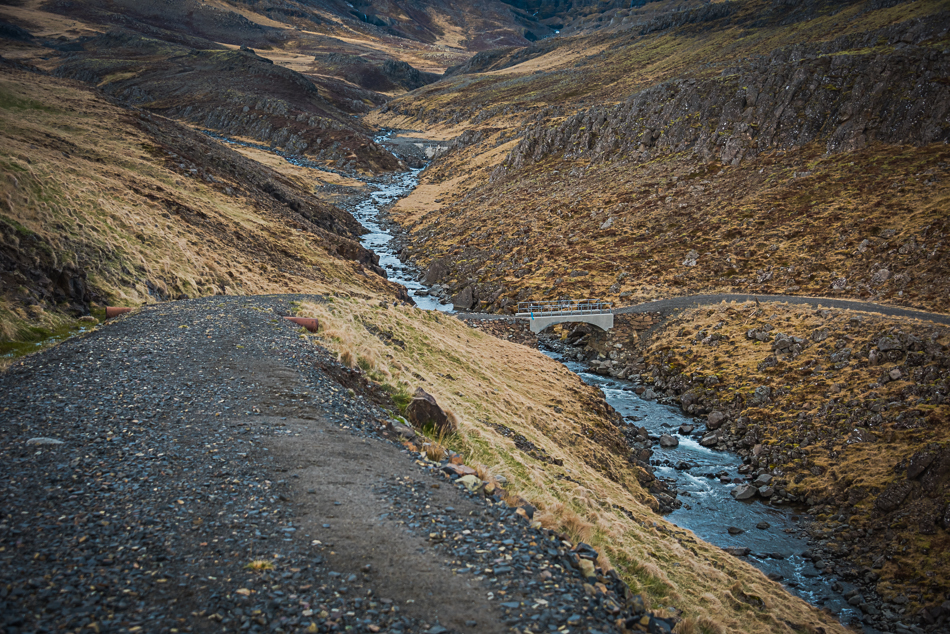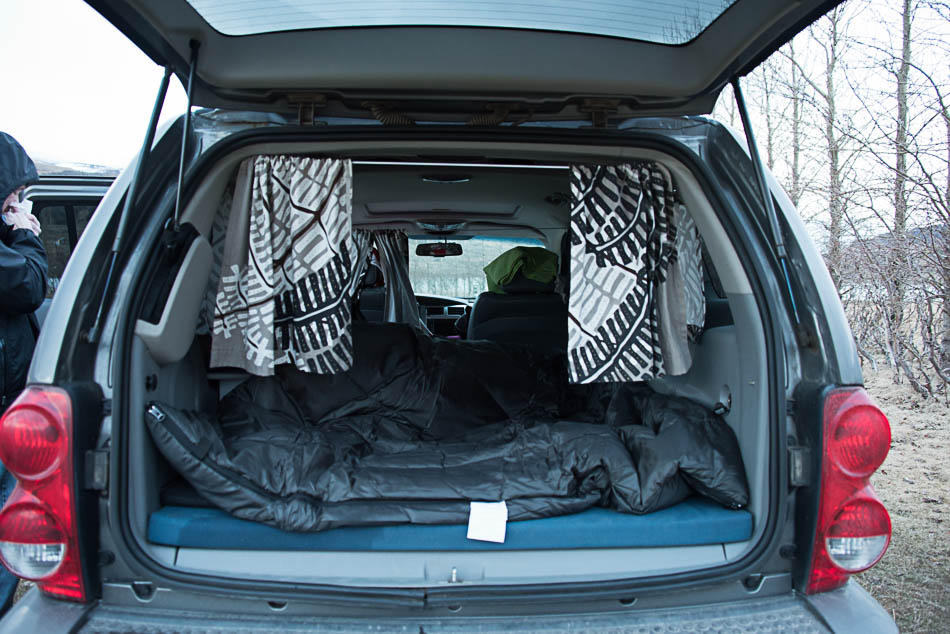We’re remarkably un-jet-lagged today, although as far as I could tell this morning, it could be three days later and we slept the whole time! Multi-hour flights tend to mess with your sense of equilibrium so you wake up at a weird time, fuzzy and unsure of where and when you are. I woke up the morning after our flight to Stockholm a few years ago at about 3 AM — but the light outside (the sun really didn’t completely set) made it feel lie noon. I was ‘off’ for days.
Iceland isn’t quite that bad yet — it still does get dark at night, at least the middle of the night. It won’t be midnight sun for a few more weeks, but it’s pretty bright outside by four. We fell into a stupor after dinner last night, barely able to summon enough energy to get undressed and brush our teeth. I’m not entirely sure I remembered to do that, really, but I woke up six hours later as if time had simply stopped, in the same position, my face stuck to the pillow with drool. Yes, so attractive, I know.
Breakfast is always a surprise when you travel — is the place you are visiting the sort that does the full-on meat-and-potatoes breakfast, with piles of delicious, yummy bacon? Or are they the more acetic sort that have a cup of espresso and a wafer of bread for breakfast? Oatmeal or cereal? Fruit or chocolate?
Mark never cares as long as there is coffee. The breakfast offerings at the Hotel Vellir were pretty typical for Iceand: Yogurt, toast, jam, ham and cheese, granola. Being a large hotel, there was hot oatmeal and eggs, too. And coffee. Icelanders know how to do coffee– black, hot, and plentiful.
We packed everything up and headed off into the world. The folks at Kuku recommended we head off clockwise — based on the weather forecast (at Vedur.is) the south was going to be cloudy and rainy, while the north was supposed to be sunnier. Since we absolutely wanted to drive around the Western Fjords, north it was!

Heading north around Reykjavik was quite a change from the stark fields of lava that stretch between the airport and the city. As soon as we left the northern suburbs (which takes only a few minutes, Reykjavik is a small city) things suddenly were green. The main road, Route 1, skirts the coast here, driving along the deep fjords. We had to resist the urge to stop every four minutes to take pictures, although we did stop at the first waterfall we saw, the tiny cascade of Tungufoss.
The drive along Halvarfjordur is lovely. Mark was instantly attracted to some pile of stuff that looked vaguely military, and so we stopped to clamber down the hill to see the pier. It is Hvitanes, the remains of a naval base from WWII, used by the British and Americans, to maintain an anti-german submarine barrier. Just some concrete buildings remain among the piles of gravel and stone, from an installation that had over 250 buildings and even had streetlights and a cinema!
I had no idea that Iceland was invaded by the British in order to keep the island out of the hands of the Germans. Its location provided a perfect base for German U-Boats, and it was considered a huge risk for the tiny island to defend itself. Britain offered to aide Iceland to protect its shores, but was rebuffed. So, on May 10, 1940, the British navy took over with barely a murmur from anyone, in a Royal Navy operation codenamed Operation Fork. They landed, took control of communications and transport, arrested German citizens, and basically settled in without any resistance from the Icelanders. They remained — reaching almost 30,000 soldiers — until the end of the war.

Whereas I will trek for miles through wet sheep pasture and mud to see castles or other piles of rocks in the various countries we visit, Mark is lured in by military sites everywhere. Empty battlefields, war memorials, that sort of thing. Military museums are always a hit. That’s the heart of a good marriage — compromise! He wanders to ancient fortifications and walls for me, and I stop at all the military stuff. We are both mystified as to why the other loves these things, but there you go. True love is standing in the wind and rain looking at The Amazing And Interesting Thing the other one likes.
But our goal today is Glymur, the tallest waterfall in Iceland. It stands in a deep ravine at the head of the fjord, and then a good hike up to the actual falls. Every single travel book or site talks about the hike to Glymur — you have to cross a river on a log. During summers, a log is braced across the river (which is not too ferocious, but definitely fast-water) with a cable stretched between two rocks. You have to walk over like a balance beam. It’s played up as the worst part of the hike to the falls, and I thought, ‘well, that’s not so bad, let’s go!”.
The log-bridge isn’t bad at all. But what all the travel guides fail to mention is the cave you have to climb through, and the very steep, very muddy climb up the cliffside with a rope hand-rail that you need to pull yourself up hand-over-hand in some places. Oh, no, the log is the biggie! Seriously? The trail snakes up the edge of the cliff, and there were times when both of us had to use the ropes to keep making forward progress. It was rainy and muddy, which made it harder; it might not be so difficult if the path was dry. Or if I was in better shape and my heels didn’t hurt.
At some point, I remember thinking, “I really hope that this is not representative of all the hikes to waterfalls and glaciers in Iceland. This has to be one of the harder ones, right? They can’t all be like this…..” (and, now that we’re back, I can attest that this was the hardest climb we did — although keep in mind that we didn’t hike anywhere in the interior/highlands). Of course, this was just after I stopped to catch my breath and a couple of teenage hikers scampered down the trail at a run. Everyone else looked wet and bedraggled and a bit red-faced from the climb, but these two were hopping around like mountain goats. Ah, to be young again.
I’m still only four months out on the surgery on my right heel, so hiking around Iceland for two weeks is a rather optimistic goal. Oh, sure, it sounded like a good idea when we made the reservations, but its definitely going to be harder than I thought. Good hiking boots help, but I still get stuck periodically — if my heel comes down lower than the rest of my foot? I’m stuck. I can’t move until I twist around and hop a bit, which is rather hard on a 45° slope. It was slow going, but the views down the valley are stupendous, even in the rain.

About 3/4 of the way up, I decided that my feet hurt and it was the first day and I didn’t want to be crippled for the rest of trip. I sat on a rock and admired the views while Mark hiked the rest of the way. It did stop raining, mostly.
Glymur is pretty impressive. A new highland waterfall, though, has been measure as taller, so it has fallen (at least unofficially so far) off the ‘-est’ list. I’m thinking if the climb to the new one is anything like this, I will probably just have to appreciate the pictures that other people take.
Cold, wet, and a bit sore, we made it back to the car and decided to try out the Hot Pot iceland site and look for a hot tub to soak in a bit. There are hundreds of hot tubs and heated pools around Iceland (all that geothermal energy and hot springs have to go somewhere!) — nearly every town has a public pool (heated) and a hot tub or sauna or two. Plus, there are many ‘natural’ hot pots — stone and concrete pools heated from a nearby spring, but not really managed or owned by anyone.
A quick search revealed Hvalfjarðarlaug just along the south shore of the fjord — I had to pull up the satellite view from Google Maps to actually see how to get there (gravel road, through a farm-stead, along the coast, into the field with only a faint tire tracks, and down to the shore. GPS: +64° 22′ 25.21″, -21° 33′ 50.02″). A bit nervously, we drove through to the shore and collected our suits and towels to have a dip.

Be careful, though. The water is coming straight out of the ground, hot enough to scald. The water for this hot pot comes from a natural hot spring/well about twenty feet away, and is fed into the water by a black pipe along the ground. Mark saw the source and stuck his fingers in to test the water temp — bad idea. It was scalding hot, nearing 200° at the source. Water, just short of boiling, is oozing up from the beach in a little shallow depression…where else by Iceland? The black pipe runs along the ground and dribbles bits of hot water into the tub, keeping it hot. If the water is too hot, move the pipe away, if it’s cooling off, lower the pipe so more water flows in. There isn’t any other source of water — so this pot could be extremely hot, test first!
The rocks are a bit slimy with algae, but the water is blissfully warm, doesn’t stink too badly of sulphur, and you can relax and look out over the fjord and the rolling clouds. I’m not really a hot tub aficionado, I get too hot and it ceases to be relaxing after about two minutes. I don’t even take really hot showers — give me a warmish pool to laze about in and I’m fine. Mark, though, loves to poach himself whenever possible.
Which does bring up the question as to why we never got a hot tub at home. We have the space, we could have tucked on in beside the deck. It’s not like we get super-cold weather or weeks of freezing to make it impossible to use. Friends of ours had one on the deck outside their bedroom, and soaked in it almost every night. Great for aches and pains, and the experience of a nice glass of wine while sitting in the tub in winter with snow falling is actually pretty tempting. But they are pain to have, expensive to run, and most people that I know have gotten rid of them after a few years. I think we just figured it was too much of a hassle. Maybe because the primary options around here are enormous backyard-pool-sized monstrosties that seat 16 people. I know small ones exist, but I haven’t actually seen them. Is there such a thing as a two-person tub?
We soaked until we felt pretty mushy and relaxed, then spent a half-hour climbing out and trying to dry off. The wind is a bit chilly after you’ve been par-boiling yourself in 104° water. I had to look up what the ‘normal’ temp is for a hot tub in the US (it’s 100°) and try to translate that to icelandic tubs. You want between 38° and 40° — be careful of the warnings, there are places where the temp could be variable: remember that this is coming straight out of the ground, no heater involved.
The roads in iceland can be a bit hairy at times. Here, just off Route 1, the roads are paved and lovely, but you often pass by evidence that things have not always been that way. The roads are remarkably modern — in some cases being finished in the last decade or so. Before that? Narrow gravel tracks were the norm around the island, even in populated areas. And these narrow little gravel road snaked around the shore of Hvalfjordur like a goat-path, the many rivers and creeks bridged by narrow bridges of concrete (or wood!). One example of such a bridge is the Brú a Bláskedggsá — a narrow span of concrete built in 1907 (to replace a dirt road along the shore that was impassible in winter and difficult in spring) and used until 1951. This was a primary road around the fjord. Oy!

Since we are new to this camping thing, we decided to head to the nearest campground marked as open along our route. I had put together a map with all of the campgrounds that said they were open on May 1, and the nearest is Þorisstadir, just a little bit north of the north shore. It was near sunset when we arrived, to discover that the camping websites and tourist webpage of Iceland lied about opening times. They were not open! The dates in the various listings of campgrounds is, apparently, just a guideline. Half the time the various sites disagreed. Oh, not on purpose, but they were wrong more often than not — people running the campgrounds opened them once they started getting some demand and when it was warm enough to turn on water to the various services and toilets. Which might not be quite May 1 as advertised.

We found the campground easily enough, but it was totally empty. Lovely place — a huge field looking out over a lake, some tall trees for privacy, a (unfortunately locked) toilet and shower block. Well, this isn’t good. We called the contact number for the campground and were told very nicely that they weren’t open yet, it had been too cold. But we were welcome to stay anyway, since we had a camper and were pretty self-contained. I think they may have assumed that we had a chemical toilet somewhere in our little Durango, but hey, it works for me. We offered to pay, but were rebuffed. So we drove back out, picked the most picturesque spot to park, and stopped for the night.
Sleeping in the back of the camper requires some readjustment of luggage and stuff. Putting bags in the front seats, unrolling the truly enormously puffy sleeping bag and getting that situated, and piling the various bits of stuff we have anywhere but the mattress. The photo above is a bit misleading, too — the area to sleep in the back is impinged on by the cabinet on the left containing the sink, storage, fridge, and stove. It juts about 15″ into the edge of the mattress. Our sleeping bag is a two-person bag, extra tall, so it fills up the entire space and then some. This is a bit of an issue, the extra poofiness makes it hard to get in and out. It’s probably overkill for the temps we’ve encountered.
This just might work.
It’s a bit narrow, so we have to sleep like spoons, really, and we realized that we had to roll at the same time, synchronized-sleeping. Comfortable? Not too bad.The camper has a heater — a separate gas motor can run it all night if we want. After running it for a half hour while we got ready, we decided we did not want it. It will heat up that space amazingly well. We turned off the heater, and fell asleep.
I think both of us were tired enough we didn’t realize we hadn’t eaten dinner, just handfuls of gorp/trail mix.

My favorite line, ” Mark was instantly attracted to some pile of stuff that looked vaguely military….”
Then, later, of course I loved the part about “True love is standing in the wind and rain looking at The Amazing And Interesting Thing the other one likes.” 🙂